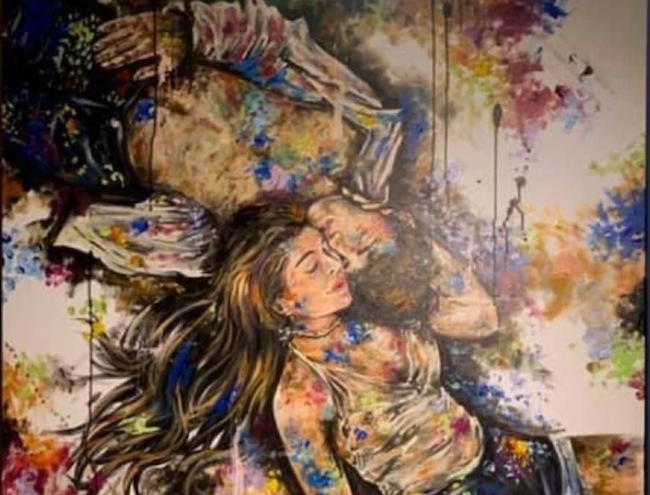Raccontare le sensazioni che avvolgono il vivere contemporaneo è parte del punto di osservazione di molti artisti i quali sentono il bisogno di interpretare e svelare tutto quel mondo interiore che spesso galleggia inconsapevolmente nelle profondità e che può giungere alla consapevolezza solo attraverso uno sguardo in grado di andare oltre, scoprendo ciò che resta apparentemente nascosto e che la sensibilità dei creativi è in grado di leggere con chiarezza. L’eclettica e poliedrica protagonista di oggi mostra quella particolare profondità emotiva attraverso cui riesce a mettere su tela significati profondi e metafore nascoste negli sguardi dei protagonisti delle sue opere.
Tutta la prima metà del Ventesimo secolo ha costituito un’importante esplorazione della psiche umana, delle sue pulsioni, delle sue emozioni che erano tenute in disparte dall’arte dei secoli precedenti in cui ciò che doveva prevalere era l’estetica, l’attinenza all’osservato senza che l’artista intervenisse dando una sua interpretazione o lasciando impresse le proprie emozioni. Il disequilibrio con la perfetta armonia rappresentativa e priva di emozione è stato necessario per i primi teorici di questo nuovo percorso espressivo, i Fauves, che decretarono un netto distacco da tutte le regole classiche e accademiche costituenti, fino a poco prima, i princìpi irrinunciabili dell’arte, con qualche eccezione costituita dal Romanticismo inglese, in cui prioritario era il rapporto tra l’esiguità dell’uomo e la forza della natura in grado di indurre l’essere umano a percepire il senso di precarietà e di finitezza pienamente evidente nelle celeberrime opere panoramiche di William Turner, e dal Simbolismo in cui il legame con gli enigmi e i misteri dell’esistenza si connetteva in qualche modo all’intuizione piuttosto che all’osservazione della realtà, mettendo dunque in primo piano le sensazioni dell’autore dell’opera. Con il passaggio dalle teorie dei Fauves all’Espressionismo la figura umana con tutto il suo sentire, piacevole o sgradevole o a volte spaventoso, divenne centrale nella produzione artistica di grandi maestri come Edvard Munch, Egon Schiele, André Derain che, ciascuno con il proprio personale approccio, si concentrarono sulle pulsioni, il disorientamento e le angosce dei personaggi rappresentati. La gamma cromatica era irreale, forte e intensa proprio per accordarsi al sentire più che all’apparire che invece era ritenuto punto focale del Realismo in cui ciascun dettaglio, ogni espressione doveva essere pura descrizione del soggetto immortalato senza che il suo volto o le sue pose cercassero un approfondimento rispetto alla pura apparenza. D’altro canto l’evoluzione delle linee guida di quest’ultimo condusse già a partire dalla metà degli anni Cinquanta del Ventesimo secolo verso una trasformazione espressiva che sfociò nel Realismo Americano, in cui focali erano proprio le atmosfere e il sentire dei personaggi e delle scene immortalate, così come le riflessioni sulla società dell’epoca, i disagi, la solitudine, tipica delle opere di Edward Hopper, o i ricordi di un passato lontano eppure ancora recente, come nel caso delle affascinanti tele di Jack Vettriano, scozzese ma appartenente al medesimo filone espressivo. La produzione artistica di Federica Raso, in arte Femya, mescola Espressionismo e Realismo personalizzandoli in uno stile con cui dare voce ai suoi personaggi intensi, in bilico tra l’essere e l’apparire, tra l’affermare la loro fisicità sulla tela e il desiderare che i pensieri, il sentire, il desiderare, venga ascoltato dall’osservatore come se egli fosse il fondamentale interlocutore con cui interfacciarsi.
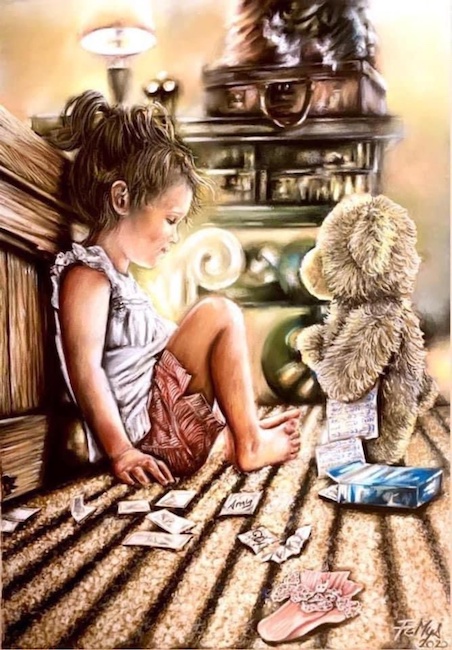
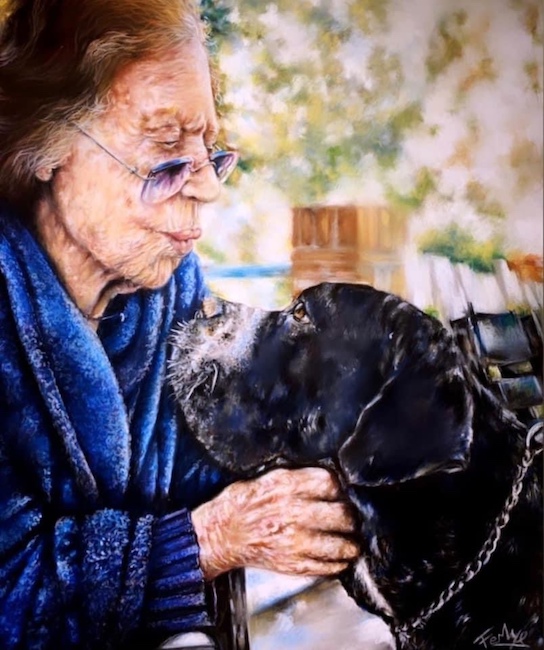
Da un lato la definizione della realtà, l’attenzione al dettaglio, al particolare che definisce le donne e gli uomini raccontati da Femya, dall’altro l’utilizzo della gamma cromatica come se fosse un prisma attraverso il quale l’artista va a osservare l’intenzione, il senso di una posa, di uno sguardo, di un frangente di vita di chi passa sotto la sua attenta lente di ingrandimento, quella emozionalmente empatica al punto di indurla a tralasciare a volte l’attinenza ai colori reali per usare quelli che più si accordano all’istante rappresentato. Usa il colore e il bianco e nero in maniera sapiente Femya, come se a volte fosse necessario annullare tutto ciò che potrebbe distrarre dalla narrazione oppure, al contrario, esaltarla attraverso tonalità incredibilmente affini alla realtà perché funzionali a mettere in evidenza una movenza, uno sguardo, un’emozione che ha bisogno di essere vista nel suo pieno Realismo per essere compresa poi a livello più interiore.

Nell’opera Explosion l’attenzione è tutta rivolta al pathos emotivo del ballerino impegnato in un salto, dal quale si evince lo sforzo fisico ma anche l’intensità dell’espressione del corpo, una passione incontenibile per la danza che diventa mezzo per dare sfogo alle pulsioni emozionali, agli impeti altrimenti trattenuti; in questa tela tanto è importante per Femya catalizzare l’attenzione del pubblico da rinunciare completamente al colore, descrivendo il suo personaggio in scala di grigi, proprio per sottolineare l’essenza interiore che deve prevalere sulla forma esteriore, la sostanza che domina l’esteriorità.
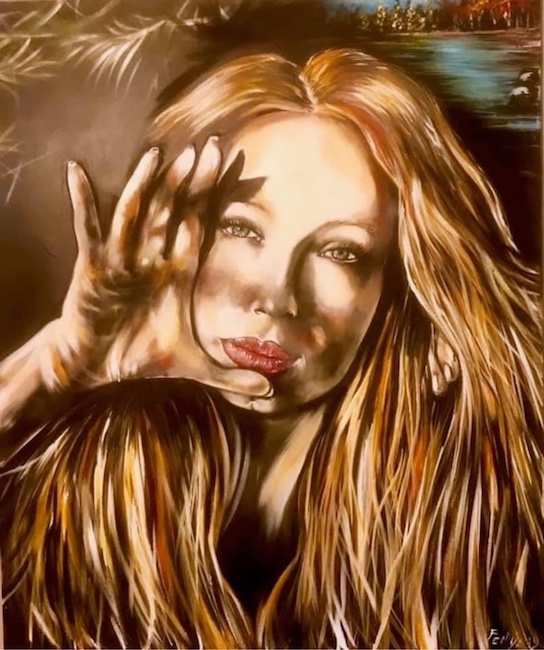
Di contro invece in I see you l’artista sceglie il colore più fedele alla realtà, fatto di sfumature, di chiaroscuro attraverso il quale l’espressione della donna protagonista viene sottolineato, uno sguardo a metà tra il disilluso e il diffidente, come stesse comunicando a qualcuno che è entrato e uscito dalla sua vita, che è in grado di vedere oltre le bugie raccontate, gli inganni perpetuati, l’inafferrabilità e le assenze momentanee; il paesaggio sullo sfondo in alto, forse rappresenta il luogo idilliaco dove si è svolto l’incontro da cui poi il concatenamento di circostanze hanno condotto la ragazza a dire basta, perché malgrado tutto ha capito l’importanza di tutelarsi, di pensare a se stessa.
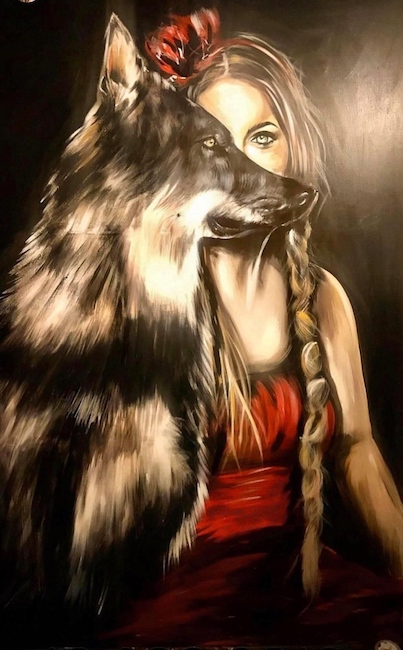
Il gioco di emozioni, l’alternanza tra l’apparire e l’essere è un dualismo che Femya fa fuoriuscire dalla tela Let me run (Lasciami correre) in cui la donna si identifica quasi con il lupo per il suo desiderio di libertà, di correre senza restrizioni o condizionamenti verso tutto ciò che desidera e si è prefissata di raggiungere; l’abito rosso indossato dalla protagonista è segno della sua forza di carattere, della determinazione che traspare dallo sguardo, lo stesso che l’artista confonde con quello del lupo, quasi come se entrambi fossero i protagonisti di una favola in cui l’uno è l’essenza dell’altra pur non potendo mostrarlo al mondo. Da qui la sensazione della ragazza di sentirsi trattenuta, di non poter liberare la sua vera natura che però non può fare a meno di emergere dai dettagli su cui viene puntato il focus; il lupo, l’alter ego o forse sarebbe meglio dire la vera sostanza della protagonista, è narrato in scala di grigio, quasi come se fosse un lato ombra costantemente presente ma mai svelato se non in alcuni frangenti.
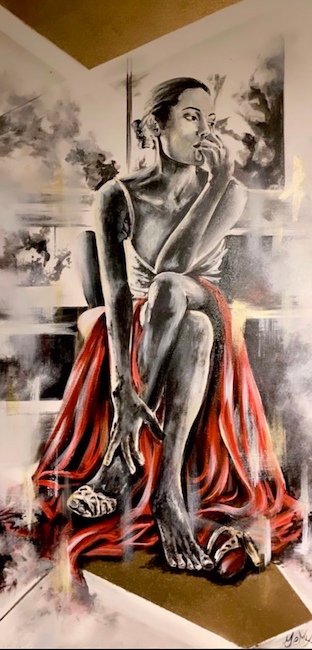
L’opera Thoughtles (Senza pensieri) rientra ancora nel dualismo espressivo di Femya in cui il bianco e nero è utilizzato per immortalare la parte inconscia della donna, quell’essere svagatamente distratta da un pensiero, un’insicurezza, una riflessione su qualcosa di accaduto che ha catturato la sua attenzione; dunque il senza pensieri del titolo appare più come un desiderio, come un auspicio che le cose possano diventare più leggere, meno complesse. La parte conscia invece, quella concreta, viene rappresentata dalla lunga gonna rossa che sembra essere più una rassicurante coperta necessaria per mantenere il legame con i propri punti fermi, con le certezze indispensabili a non perdersi dietro gli accadimenti.
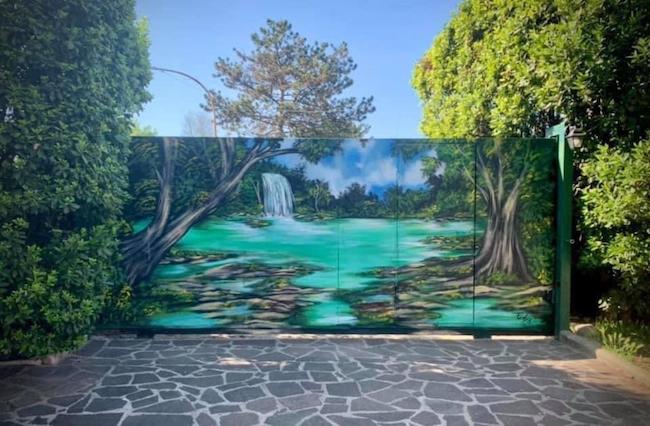
La dinamicità creativa di Femya si manifesta in questa tela attraverso l’utilizzo di smalti acrilici con i quali evidenzia quel rosso che è punto focale per mantenere il contatto della donna con se stessa, malgrado gli eventi. Mural designer, decoratrice d’interni e scenografa, oltre che artista, Femya ha recentemente creato l’originale Arte del Termosifone con cui rende protagonisti quegli elementi presenti nelle case di tutti ma spesso trascurati e inosservati. Attraverso le sue decorazioni i caloriferi prendono vita e assumono un ruolo centrale nelle abitazioni dei numerosi clienti che scelgono di dare un nuovo stile ai loro appartamenti. Federica Raso Femya è ospite onoraria della storica e prestigiosa Associazione dei Cento Pittori di via Margutta, con cui espone regolarmente nelle due mostre collettive annuali.
FEDERICA RASO FEMYA-CONTATTI
Email: raso.federica88@gmail.com
Facebook: https://www.facebook.com/federica.raso.9
Instagram: https://www.instagram.com/femya_art/
Between Realism and Expressionism with the intense and deep atmospheres of Femya’s artworks
Telling the story of the sensations that envelop contemporary life is part of the point of observation of many artists who feel the need to interpret and reveal all that inner world which often floats unconsciously in the depths and that can only come to awareness through a gaze able to go beyond, discovering what remains apparently hidden and that the sensitivity of creative people is able to read clearly. Today’s eclectic and multifaceted protagonist shows a particular emotional depth through which she manages to put deep meanings and hidden metaphors on canvas in the gazes of the protagonists of her artworks.
The whole of the first half of the twentieth century was an important exploration of the human psyche, of its impulses, its emotions, which were kept aside by the art of previous centuries in where what had to prevail was aesthetics, the relevance to the observed without the artist intervening by giving his own interpretation or leaving his own emotions impressed. The imbalance with perfect representative harmony devoid of emotion was necessary for the first theorists of this new expressive path, the Fauves, who decreed a clear detachment from all the classical and academic rules that had until recently constituted the inalienable principles of art, with a few exceptions made by English Romanticism, in which priority was given to the relationship between the smallness of man and the force of nature, leading the human being to perceive a sense of precariousness and finiteness that is fully evident in the famous panoramic paintings of William Turner, and Symbolism, in which the link with the enigmas and mysteries of existence was connected in some way to intuition rather than to the observation of reality, thus putting the author’s feelings in the foreground. With the transition from the theories of the Fauves to Expressionism, the human figure with all its feelings, whether pleasant or unpleasant or sometimes frightening, became central to the artistic production of great masters such as Edvard Munch, Egon Schiele and André Derain who, each with their own personal approach, focused on the drives, disorientation and anxieties of the characters represented. The range of colours was unreal, strong and intense in order to tune in to the feeling rather than the appearance that was considered the focal point of Realism in which every detail, every expression had to be a pure description of the subject immortalised without the face or poses seeking to go beyond pure appearance. On the other hand, the evolution of its guidelines led, as early as the mid-1950s, to an expressive transformation that resulted in American Realism, in which the focal points were the atmospheres and feelings of the characters and scenes immortalised, as well as reflections on the society of the time, hardships, loneliness, typical of Edward Hopper’s artworks, or memories of a distant yet still recent past, as in the case of the fascinating canvases of Jack Vettriano, from Scotland but belonging to the same expressive vein.
The artistic production of Federica Raso, aka Femya, mixes Expressionism and Realism, personalising them in a style with which she gives voice to her intense characters, poised between being and appearing, between affirming their physicality on the canvas and wanting their thoughts, feelings, desires to be heard by the observer as if he were the fundamental interlocutor to interface with. On the one hand, the definition of reality, the attention to detail, to the particular that defines the women and men portrayed by Femya, and on the other, the use of the chromatic range as if it were a prism through which the artist goes to observe the intention, the sense of a pose, of a look, of a moment in the life of those who pass under her attentive magnifying glass, the emotionally empathetic one to the point of inducing her at times to omit the relevance of the real colours in order to use those that are most in keeping with the instant represented. She uses colour and black and white in a skilful way, Femya, as if sometimes it were necessary to cancel everything that could distract from the narration or, on the contrary, to enhance it through tones that are incredibly close to reality because they serve to highlight a movement, a look, an emotion that needs to be seen in its full Realism in order to be understood on a more interior level. In Explosion, the focus is on the emotional pathos of the dancer as he jumps, showing not only the physical effort but also the intensity of the body’s expression, an irrepressible passion for dance that becomes a means of giving vent to emotional impulses, to impulses that would otherwise be restrained; in this canvas, it is so important for Femya to capture the audience’s attention that she renounces colour completely, describing her character in greyscale, precisely to emphasise the inner essence that must prevail over the outer form, the substance that dominates the exterior. In I see you, on the other hand, the artist chooses a colour that is more faithful to reality, made up of nuances and chiaroscuro through which the expression of the leading woman is emphasised, a gaze that is halfway between disillusioned and distrustful, as if she were communicating to someone who has been in and out of her life, who is able to see beyond the lies told, the deceptions perpetuated, the elusiveness and the momentary absences; the landscape in the background at the top perhaps represents the idyllic place where the meeting took place, from which the chain of circumstances then led the girl to say enough, because despite everything she understood the importance of protecting herself, of thinking of herself.
The play of emotions, the alternation between appearing and being is a dualism that Femya brings out in Let me run, in which the woman almost identifies with the wolf because of her desire for freedom, to run without restrictions or conditioning towards everything she wants and has set out to achieve; the red dress worn by the protagonist is a sign of her strength of character, of the determination that transpires from her gaze, the same gaze that the artist confuses with that of the wolf, almost as if both were the protagonists of a fairy tale in which one is the essence of the other even though it cannot show it to the world. Hence the girl’s feeling of being restrained, of not being able to release her true nature, which, however, cannot fail to emerge from the details on which the focus is placed; the wolf, the alter ego, or perhaps it would be better to say the true substance of the protagonist, is narrated on a grey scale, almost as if it were a shadow side constantly present but never revealed except at certain junctures. Thoughtles is another example of Femya’s expressive dualism, in which black and white is used to immortalise the woman’s unconscious side, that of being distracted by a thought, an insecurity, a reflection on something that has happened that has caught her attention; thus the thoughtlessness of the title appears more like a desire, like a wish that things might become lighter, less complex. The conscious side, on the other hand, the concrete side, is represented by the long red skirt, which seems to be more like a reassuring blanket needed to maintain the link with her fixed points, with the certainties indispensable for not getting lost behind events. Femya’s creative dynamism is manifested in this canvas through the use of acrylic enamels with which she highlights that red that is the focal point for maintaining a woman’s contact with herself, despite events. Mural designer, interior decorator and set designer, as well as an artist, Femya has recently created the original Art of the Radiator with which she makes protagonists those elements present in everyone’s home but often overlooked and unobserved. Through her decorations, radiators come to life and take on a central role in the homes of the many customers who choose to give their flats a new style. Federica Raso Femya is an honorary guest of the historical and prestigious Association of the Hundred Painters of via Margutta, with whom she regularly exhibits in the two annual group exhibitions.


